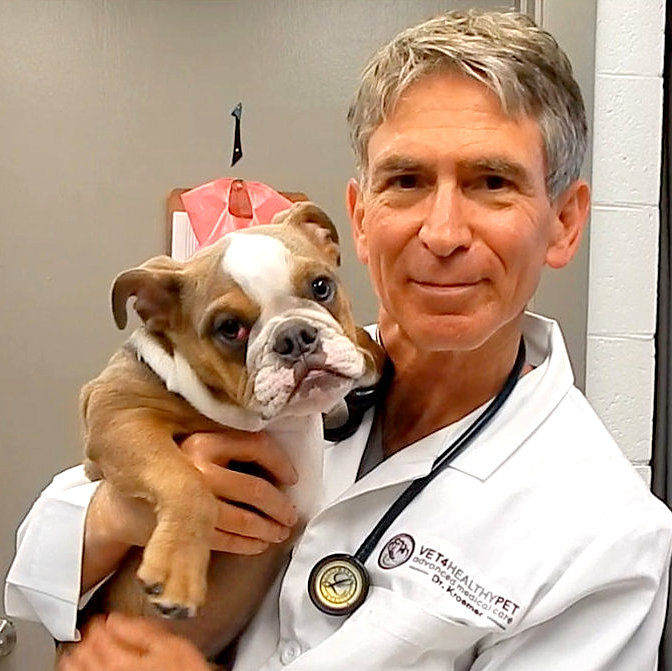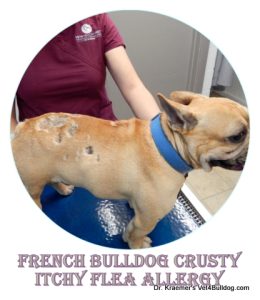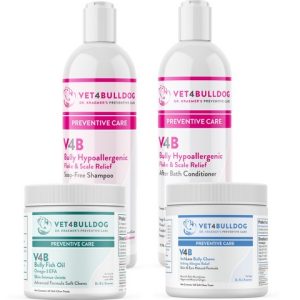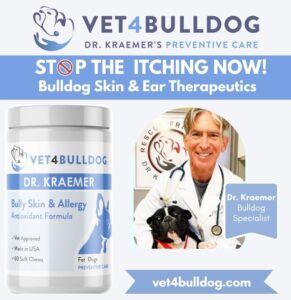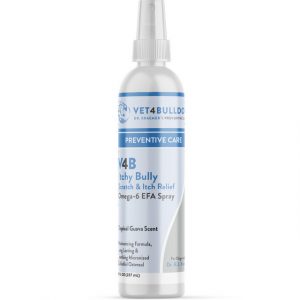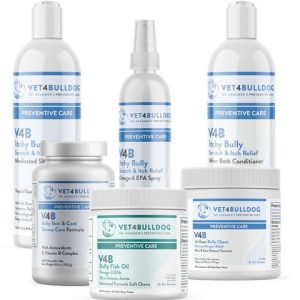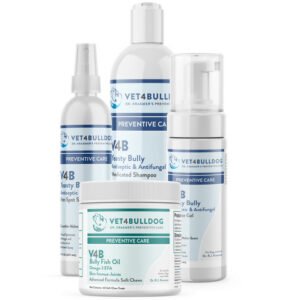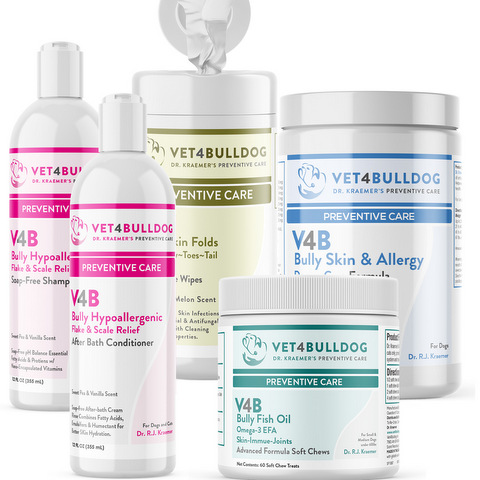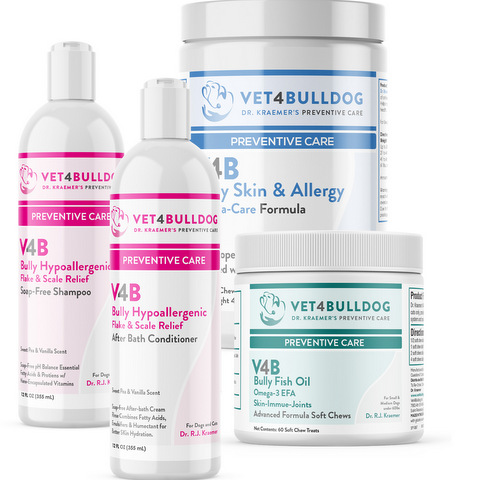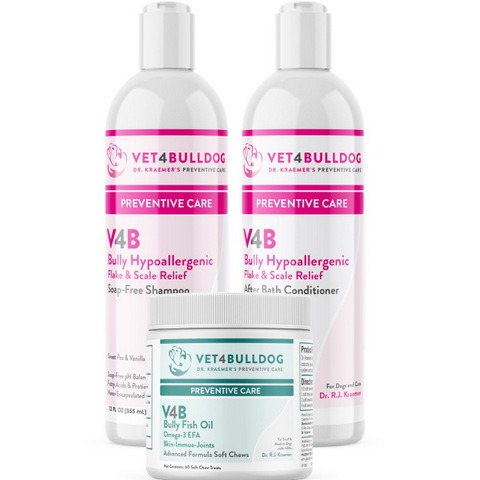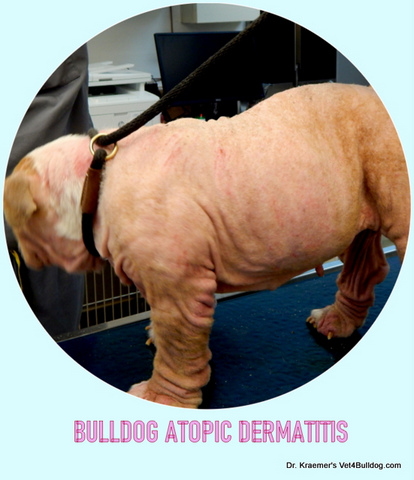Introduction to Flea Allergy in Bulldogs and French Bulldogs
Flea allergy is one of the most common skin conditions affecting pets across various geographic regions. Understanding the flea life cycle is essential for effective prevention and control.
The Flea Life Cycle: 4 X Stages
Many pet owners focus only on adult fleas, but effective control requires understanding the entire flea life cycle.
Stage 1: ADULT FLEA (5% of the Cycle)
Adult fleas are the only stage that feeds on blood, causing itching, irritation, and allergic reactions in sensitive pets. Although they comprise just 5% of the flea population, their rapid reproduction can quickly lead to infestations.
🚨Addressing adult fleas is crucial, but targeting the other stages is equally important for long-term control.
Stage #2: FLEA EGGS (50% of the Cycle)
A single flea lays clusters of 20–40 eggs directly on the host’s fur, but these eggs often fall off into the surrounding environment—carpets, bedding, and furniture.
They hatch within 1–10 days, depending on temperature and humidity.
🚨Understanding this aspect of the flea life cycle is crucial for effective prevention and control measures.
Stage #3: FLEA LARVAE (35% Of the cycle)
Blind and worm-like, flea larvae feed on organic debris, including flea dirt (dried blood from adult fleas). They thrive in dark, humid environments like carpets and bedding. As they grow, larvae molt twice before spinning a protective cocoon, preparing to enter the pupal stage.
This stage is often overlooked but is critical in flea control efforts.
Stage #4: FLEA PUPA (10% of the cycle)
Inside their cocoons, flea pupae mature into adult fleas. They can remain dormant for weeks or even months, emerging only when they sense warmth or vibrations signaling a potential host nearby. This ability makes flea infestations persist despite treatment.
This awareness of the pupae to environmental cues is crucial to the flea life cycle and factors into effective control strategies.
Flea Allergy Climate Sensitivity
Climate plays a significant role in the prevalence and severity of flea allergies in bulldogs.
- 🥶 Colder Regions: Flea allergy diagnoses typically peak during the warmer summer months when flea activity increases.
- 🔥Warmer Regions: Bulldogs may suffer from flea allergies year-round due to consistent flea reproduction in mild or hot climates.
How Temperature Affects Flea Development?
The ideal conditions for flea growth are 70-85°F (21-29°C) with 70% humidity.
In such environments, the flea life cycle accelerates, making infestations harder to control.
Understanding climate sensitivity helps bulldog owners take proactive measures, such as year-round flea prevention in warm regions and seasonal precautions in cooler areas.
What Is The Cause of Flea Allergy in Bulldogs and Fr. Bulldogs?
Bulldogs with flea allergies have an exaggerated immune response to flea saliva, which is injected during a flea bite. This hypersensitivity leads to intense itching and skin irritation.
#1 Flea Bite Hypersensitivity
- In some cases, even a single flea bite can trigger severe itching that lasts for days.
- Bulldogs with heightened sensitivity may suffer from persistent discomfort and inflammation, even when flea infestations are minimal.
Since flea-allergic bulldogs react strongly to even low flea exposure, consistent flea prevention is essential for managing symptoms and preventing flare-ups.
What Are The Symptoms of Flea Allergy In Bulldogs and French Bulldogs?
Allergic bulldogs often suffer from intense itching, most noticeable at the top of their back and around the base of the tail. This itch leads to the following symptoms:
- Itch: Severe itching is the primary issue, causing discomfort and distress for the dog.
- Hair Loss: The dorsal lumbar region and the tail base are common areas where hair loss occurs due to scratching and irritation.
- Discoloration: Redness and discoloration in the affected areas are frequent, indicating inflammation and skin irritation.
- Secondary Infection: The damaged skin barrier from constant scratching can lead to secondary infections, worsening the condition.
Effective management and timely veterinary care are crucial to alleviate discomfort and prevent further skin damage in allergic bulldogs.
How To Diagnose Bulldog Flea Allergy?
There are several simple ways to help diagnose fleas and flea allergy
#1 FLEA POOP:
Diagnosing flea allergy in bulldogs begins with detecting the presence of fleas and their distinctive black, pepper-like droppings, known as flea dirt. This debris is the digested blood expelled by fleas after feeding.
#2 FLEA COMB:
To effectively identify fleas, using a flea comb in areas like the suspected regions is highly recommended.
#3 FLEA ALLERGY HAIR LOSS DISTRIBUTION
Back Near Tail Base: Regular checks of key areas, most commonly the dorsal back, pelvis, and tail base areas are crucial for early detection and prompt treatment of flea infestations. This proactive approach ensures the comfort and health of your bulldog by addressing flea-related issues before they become more severe.
Belly Area: Fleas are often found around the hind legs and in the hairless sections of the belly, where they are more visible and easier to spot.
How To Prevent Flea Allergy in Bulldogs and French Bulldogs?
Flea infestations primarily occur in the environment, not just on your pet. Around 95% of the flea cycle takes place off your dog and in your home or yard, making it essential to use preventive products with a residual effect to prevent re-infestation. Without this, fleas may quickly return, causing ongoing problems.
Around 95% of the flea cycle is not on your dog
#1 Monthly Insecticides Flea Preventives:
There are numerous oral and topical flea preventatives, most of which last for about 30 days. Some products, like Bravecto, can last for up to three months. Many of these preventatives also offer additional protection against other pests and conditions, including:
- Tick prevention
- Demodex mite prevention
- Heartworm prevention
- Intestinal parasite preventatives
POPULAR PRESCRIPTION FLEA PREVENTIVES
- NexGard
- Bravecto
- Simparica
- Revolution
NON PRESCRIPTION FLEA PREVENTIVES
- Frontline
- Advantage
- Many other generics
#2 Environmental Flea Egg and Larvae Prevention:
In addition to monthly flea preventatives, you can help control flea infestations by treating your home and yard, especially in severe cases.
To effectively manage fleas in your environment:
- Regularly vacuum upholstery, carpets, and bedding
- Wash your dog’s bedding regularly
- Treat the yard with insecticidal sprays
FLEA PREVENTIVE WARNING:
⚠️ Some commonly marketed flea control products have limited or no proven effectiveness.
These should not be relied upon as stand-alone preventives, as most of their claims lack clinical evidence. Some of these include:
- Flea neck collar repellents
- Herbal remedies
- OTC garlic
- “Natural,” “organic,” and “holistic” flea prevention and treatment products
- Essential oils
While alternatives like garlic and essential oils are often promoted, they lack scientific backing and can be harmful to pets if ingested or applied topically.
Your vet will guide you on the appropriate product based on your pet’s age, breed, health, and lifestyle, ensuring effectiveness and safety.
#3 Flea Shampoo:
Flea shampoos may offer temporary relief, but they do not provide lasting protection. While they can help manage immediate infestations, they do not address the root of the problem.
For continuous and effective flea control, use preventive measures that offer extended protection.
#4 Year-Round Flea Prevention Benefits:
A common mistake is stopping flea prevention once the itching subsides. Consistent, year-round flea prevention is essential for:
- Preventing flea-borne diseases
- Avoiding tapeworms
- Reducing stress and itching
- Preventing secondary skin infections like dermatitis (bacterial and yeast infections)
- Preventing anemia, especially in young puppies and kittens, as blood loss from flea feeding can be critical.
Maintaining regular flea prevention ensures long-term health and comfort for your bulldog and French Bulldog, reducing the risk of flea allergies and related complications.
How to Treat Bulldog Flea Allergy Successfully?
Successfully treating a bulldog’s flea allergy involves several factors, including the severity of the infestation, environmental conditions, and the presence of multiple pets in the household.
There are a number of common means to prevent and treat fleas and flea allergy
#1 Flea Prevention for All Pets:
In homes with multiple pets, it’s crucial that every pet—especially those that go outdoors—are consistently treated with flea preventatives. Fleas can easily transfer between pets, and if one pet is untreated, it can lead to reinfestation and ongoing allergic reactions in others.
#2 Flea Environmental Control:
Fleas live not only on your pet but in your environment as well. Treating your home and yard is a critical part of the treatment process. Regular cleaning, vacuuming, and using insecticidal treatments can help eliminate flea eggs, larvae, and pupae, breaking the flea life cycle.
#3 Use of Flea Preventatives:
It’s important to continue using monthly flea preventatives that are effective for the long term. Options like oral medications or topical treatments with residual effects can help ensure that fleas are kept at bay.
#4 Comfort and Itch Relief:
Providing relief from itching is vital. Anti-itch medications, steroids, or antihistamines may be prescribed to help reduce inflammation and soothe the affected areas.
Additionally, applying a soothing bully therapeutic spray can help reduce itch and discomfort.
#5 Treat Secondary Infections:
Since flea allergy can lead to secondary skin infections (like bacterial or yeast infections), it’s essential to treat these as well. Your veterinarian may recommend medications like antibiotics or antifungal creams to manage infections, along with bully therapeutical medicated shampoos to soothe irritated skin.
Hoe To Prevent Flea Allergy Recurrence?
To prevent future flea allergy flare-ups:
- Continue flea prevention year-round, even during the colder months when fleas are less active.
- Treat the environment regularly, especially if you live in an area with high flea populations.
- Consult your veterinarian for regular check-ups to ensure your bulldog’s flea prevention regimen is up-to-date and effective.
A comprehensive approach—focusing on flea control, treating secondary infections, and using ongoing prevention—is essential for successfully managing flea allergies in bulldogs. This ensures their comfort and long-term health.

How To Control Itch in Bulldog and French Bulldog?
While waiting for flea preventatives to take full effect, managing your bulldog’s itch and discomfort is crucial. Flea Allergy Dermatitis (FAD) can cause intense itching, leading to skin irritation, hair loss, and secondary infections.
#1 Itch Control Allergy Medication
There are a few effective prescription medications for itch control, but most come with potential side effects that increase with prolonged use.
A. STEROIDS
⚠️ Steroids are highly effective for acute flea allergy flare-ups providing rapid relief.
- Steroids do not eliminate fleas; they only temporarily relieve symptoms.
- Steroids are not safe for long-term use due to potential side effects.
- Prolonged steroid use can lead to immune suppression, weight gain, cushings, diabetes, and other complications.
B. OTHER ITCH CONTROL RX MEDICATION
- Apoquel: Targets itching at a deeper immune level, often used for allergy-related itch.
- Antihistamines: These can help in mild cases but are generally less effective than steroids or Apoquel.
C. OTC ITCH CONTROL RX
While antihistamines (Benadryl, Zyrtec, Claritin) can be used, they are generally not strong enough to fully control flea allergy itch.
These can be safely combined with other treatments but should not be relied on as a sole solution.
#2 Non Prescription Bulldog Itch Control Therapeutics
In addition to prescription and OTC options, non-prescription therapeutics should be included to manage allergies, itching, and secondary skin infections:
A. ALLERGY ITCH CONTROL BULLY TOPICAL THERAPEUTICS
- V4B Bully Medicated Hypoallergenic shampoo
- V4B Bully Medicated Hypoallergenic Conditioner
- V4B Bully ItchLess Spray
For a low-cost Bully ItchLess Bundle, click HERE
Severe and uncontrolled flea allergies can frequently lead to a secondary bacterial infection.
B. INFECTION ITCH CONTROL TOPICAL
The intense itching associated with these allergies can cause damage to the bulldog’s skin barrier, creating conditions conducive to the development of secondary bacterial and yeast infections.
Addressing flea allergies promptly is crucial to preventing and managing these additional complications.
- V4B Yeasty Bully Antiseptic Medicated Shampoo
- V4B Yeasty Bully Antiseptic Medicated No-Rinse Gel
- V4B Yeasty Bully Antiseptic Hot-Spot Medicate Spray
For a low-cost Antiseptic Bully Bundle, click HERE
C. FLEA ALLERGY THERAPEUTIC SUPPLEMENTS:
Bulldog Flea Allergy Rule of Thumb
The flea life cycle consists primarily of eggs, larvae, and cocoons, with adult fleas making up only 5% of the total population and living for a short time.
Flea Allergy Tips & Warning
Below is a short list of bulldog flea allergy tips and warning courtesy of Dr. Kraemer
#1 Flea-preventive Neck Collar Tip:
Flea Collars: Limited Effectiveness
Weak & Short-Lived Repellent Effect
- Most flea collars provide only mild and temporary repellent action.
- Fleas can bypass the collar or develop tolerance over time.
Contact Kill Claims
- Some collars claim to kill fleas on contact, but the insecticide concentration is often too low to be truly effective.
- Many fleas avoid direct contact with the collar, reducing its impact.
For reliable flea prevention, veterinarian-recommended oral or topical treatments are far more effective than flea collars.
#1 Flea Allergy Infection Warning:
Poorly managed flea allergies have the potential to progress to infectious and yeast dermatitis secondary to the flea allergy. Timely and effective management is essential to prevent complications and ensure the overall well-being of your bulldog.
#2 Flea Allergy Anemia Warning:
Chronic allergies, if not effectively managed, can lead to anemia, especially in young kittens and puppies.
#3 Flea Allergy Orthopedic Problems Warning:
Intense itching can subject your bulldog to stress and pose a risk of orthopedic injuries due to frantic scratching and reaching sensitive areas.
#4 ⚠️Fleas Tapeworm Warning:
Adult fleas act as carriers of tapeworms, transmitting the parasite when a bulldog licks its fur and ingests an infected flea. The presence of small, rice-like grains near your bulldog’s rear is a strong indicator of tapeworm infection and confirms prior flea exposure.
What to Do:
- Seek veterinary care immediately for proper diagnosis and treatment.
- Early intervention helps prevent discomfort and potential complications.
- Consistent flea prevention is key to avoiding future tapeworm infections.
Maintaining vigilance in flea control not only prevents tapeworms but also protects your bulldog’s overall health and well-being.
#5 Flea Preventive OTC Garlic Toxicity Warning:
While some studies suggest garlic may have flea-repellent properties, the evidence is weak and inconclusive. The exact dosage required for effectiveness in dogs remains unknown and potentially dangerous.
#6 Flea Preventive Organophosphates Warning:
These older insecticides, once widely used in flea collars and sprays, are now largely phased out due to their high toxicity risk. Organophosphates (OPs) can lead to severe neurological symptoms, including tremors, seizures, and even fatal poisoning if ingested or absorbed through the skin.
#7 Flea Preventive Carbamates Toxicity Warning:
Similar to OPs, carbamates are insecticides that can cause nervous system problems in pets. While not as potent as OPs, they can still be risky, especially for young animals or those with sensitive skin.
#8 Flea Preventive Permerthrines Toxicity Warning:
These synthetic pyrethroids are commonly found in flea and tick collars and topical treatments. While generally safe for most dogs, permethrin can be very toxic to cats, causing neurological issues and even death.
Always ensure any product containing permethrin is specifically labeled for dogs and keep it away from cats.
#9 Flea Preventive Isoxazolines Warning:
This newer class of insecticides is effective against fleas and ticks but has been linked to neurological side effects in some dogs, like tremors, ataxia, and seizures.
The risk is considered low for healthy dogs, but it’s crucial to discuss potential side effects with your veterinarian before using an isoxazoline product, especially for breeds known to be sensitive to medications.
Examples:
- NexGard
- Bravecto
- Simparica
Trusted by Vets ~ Recommended By Owners ~ Approved By Bulldogs



